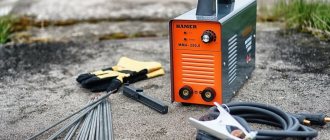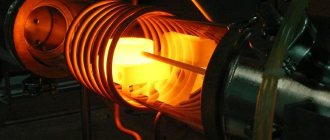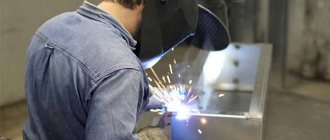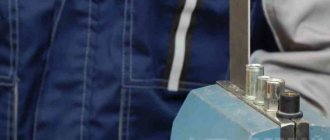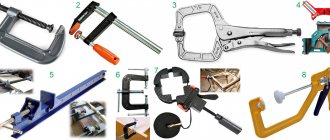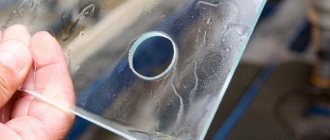Home / Devices
Back
Reading time: 6 min
0
1436
Corrosion-resistant steel, or stainless steel in everyday life, is the most necessary material in the household.
Household utensils are made from this alloy steel; many car parts are also made from stainless steel.
Alloy steel, which is well used in everyday life, is difficult to heat treat during welding.
Inconveniences are expressed by the existence of an oxide film on the surface of products, which melts at a temperature of at least 2,000° C.
However, there are techniques that allow you to repair or connect stainless steel parts by welding and even at home.
The best way for this operation is considered to be the use of TIG technology - manual welding with a non-consumable rod in an inert controlled atmosphere - argon.
The resulting seams are distinguished by their accuracy and reliability, which is necessary when working with alloyed metal.
- General information
- Apparatus for household work QUATTRO ELEMENT MULTI PRO 2100
- FUBAG IRMIG 200 SYN
- FOXWELD INVERMIG 185
- SVAROG PRO MIG 160 SYNERGY
- AURORA SREEDWAY 175
Difficulty factors for welding stainless steel parts
Welding stainless steel is complicated by the fact that this material belongs to the category of high-alloy alloys, which means that its composition contains elements in fairly large quantities that affect its basic properties. In stainless steel, in particular, this element is chromium. Its content in this alloy can be 12–30%. Chromium, along with elements such as nickel, titanium, manganese and molybdenum, forms the anti-corrosion properties of stainless steel, but at the same time gives it other features that affect weldability.
For those who do not like to read long articles and delve into technical details, we suggest you immediately watch two videos with the most relevant options for welding stainless steel for a home craftsman - with an electrode using an inverter and again with an inverter, but in a shielding gas (argon).
Welding of stainless steel must be carried out taking into account the following specific characteristics of this material.
A fairly high coefficient of linear expansion.
For this reason, welding of stainless steel is always accompanied by significant deformation of the parts being joined. In some cases, when the parts being welded are of significant thickness and there is no gap between them, such deformations can even lead to the appearance of large cracks.
Low thermal conductivity
The thermal conductivity of stainless steel is 1.5–2 times lower than that of low-carbon alloys. This feature of the material leads to the fact that the parts being connected in the welding zone are melted even at lower (15–20%) current strengths than when welding products made of low-carbon steel.
Intergranular corrosion
With strong heating (more than 500 degrees Celsius), so-called intergranular corrosion occurs in stainless steels. This happens because layers consisting of chromium and iron carbide begin to form at the edges of the grains of the metal structure. This phenomenon can be avoided not only by careful selection of the welding mode, but also by forced cooling of the stainless steel parts being welded, for which you can use ordinary water. However, it should be borne in mind that only parts made of chromium-nickel steels that have an austenitic internal structure can be cooled with water.
Overheating of electrodes with chromium-nickel rods
Due to the low thermal conductivity of the materials being joined and their increased electrical resistance, welding of stainless steel parts is accompanied by strong heating of the electrodes, the rods of which have a chromium-nickel composition. To avoid this undesirable phenomenon, use electrodes for welding stainless steel up to 35 cm long.
Welding electrodes Sabaros ME 101 3.2 mm for welding stainless steels
The most common methods of welding stainless steel
Welding of stainless steel products characterized by a high chromium content can be performed using several technologies. This includes, in particular, the following types of welding:
- argon arc (using a tungsten electrode and AC/DC TIG modes);
- performed in MMA mode with coated electrodes;
- semi-automatic arc welding in an argon environment, carried out in MIG mode and using stainless steel wire;
- so-called cold welding for stainless steel, performed under high pressure (the name of this technology is due to the fact that it does not involve melting the metal during the process of joining it);
- seam technology and resistance spot welding.
The technology for welding stainless steel parts involves thoroughly degreasing their surfaces using acetone or aviation gasoline. This is done in order to reduce the porosity of the seam being performed, to make the welding arc more stable, and to thoroughly clean the edges of the parts being joined. Only after thorough cleaning can you begin to perform the operation using the chosen method. There are several basic methods for welding stainless steel parts, as well as technologies that are used quite rarely. In any case, the decision on how to weld stainless steel should be based on the specific conditions and requirements for the joint being formed.
Equipment
When choosing equipment, welders do not make exceptions for stainless steel, since all work is performed using a welding inverter. There are models that are capable of performing high-quality work in domestic conditions. They are compact, powered from a household network (220 volts) and reliable.
A characteristic feature of the operation of any inverter is repeated voltage conversion. With this technology, the additive is fused into the metal more efficiently, and the seam is high-quality and smooth. Due to the fact that the prices for such devices are more than democratic, they have become accessible not only to industrial enterprises, but also to private craftsmen.
As noted above, stainless steel can be welded in the MIG or MMA mode, which means that any of the available inverters, even the simplest one, will do. It is important that the device allows precise adjustment of welding parameters, which directly depend on the thickness of the workpiece. Before work, you should treat the surface, clean it of dirt or oily substances.
It is known that when welding stainless steel, a gap must be maintained between the parts, otherwise cracks will form. When working with sheet metal whose thickness does not exceed 2 mm, no gap is needed. The edges of the parts are brought close to each other. If the thickness of the sheets exceeds 4 mm, then the edges are cut at an angle of 45° degrees, thus increasing the area of the penetration zone.
- When the metal thickness is 1.5 mm, electrodes with a diameter of 2 mm are used. The current strength is 40 - 60 A.
- Metal thickness – 3 mm, electrode diameter – 3 mm, current – 85 A.
- Metal thickness – 4 mm, electrode diameter – 3 mm, current – 100 A.
- Metal thickness – 6 mm, diameter – 4 mm, current – 150 A.
Welding with coated electrodes (MMA)
Welding stainless steel parts using MMA technology, which involves the use of coated electrodes, is the most common technology. This method is quite simple, it can be used at home, but it does not allow you to obtain the highest quality seam.
Conveniently, this kind of stainless steel welding can be done even at home, but for this you will need a special welding machine called an inverter. In order for welding stainless steel with an inverter to produce a highly reliable connection, it is necessary to select the correct electrode for a specific grade of stainless steel. All electrodes used to weld stainless steel products are divided into two main types:
- with a rutile coating based on titanium dioxide (welding with such electrodes, which provide small metal spatter and a stable arc, is performed with direct current and reverse polarity);
- with a coating based on magnesium and calcium carbonate (with such electrodes, stainless steel is welded using direct current of reverse polarity).
To understand which electrodes to use to weld stainless steel, just look at GOST 10052-75, which presents all types of such consumables, and also stipulates which one should be used for working with metal of a specific chemical composition. In order to select stainless steel electrodes that meet the requirements of this GOST, it is enough to know the grade of the metal from which the parts need to be connected.
All requirements for electrodes for welding stainless steel can be found by downloading GOST 10052-75 for free in pdf format from the link below.
GOST 10052-75 Coated metal electrodes for manual arc welding of high-alloy steels with special properties
How to weld stainless steel with an electrode at home
At home, you most often have to cook stainless steel with a cheap inverter and a conventional electrode for these steels. In this section we will focus on the features and techniques of electrode welding; this will be useful to you if you are a novice welder.
Now let's briefly look at the welding procedure.
We prepare the part that needs to be welded for welding, clean the edges to a metallic shine, it is advisable to degrease the surface.
The edges of the part themselves must be cut according to GOST if the thickness of the part is 3 millimeters or more. Edge cutting is most often done with a sander.
We connect the device. A very important point is polarity when welding. In our case, we use reverse polarity (we connect the plus of the device to the holder, and connect the ground cable to the minus).
If you don’t have a machine or need to find out what types of welding machines there are, then follow the link.
Now you need to tack so that the edges do not separate during the welding process. The tacks are placed at a distance of 100–160 mm from each other. The length of the tacks is usually from 10 to 50 mm. The tacks need to be melted or sawed off during the welding process. Practice shows that if the requirements for a seam are high (the seam will undergo non-destructive testing), then the tacks need to be cut out, otherwise pores will form.
Now you can start welding.
Let us make a reservation if you need to cook, but the air temperature is below minus 10 degrees, then the products need to be heated with a gas burner or inductor to 100 - 120 degrees.
To start welding, you need to light the arc. This is done as follows: a welding electrode fixed in a holder brings the parts and touches the surface with the end of the electrode several times.
There are 2 types of movements: pecking - tapping the tip of the electrode on the surface and striking - the same movement as when lighting a match. In this case, there are no special recommendations on what to use, here those who are used to it do so.
You need to cook stainless steel at a minimum current so as not to overheat the metal; for this you need to use electrodes with a small diameter of 1.6-2.5 mm (3 mm in extreme cases). If you use electrodes of larger diameter, the process will be greatly complicated due to overheating.
The process itself should be kept short; the length of the arc should not be more than one diameter of the electrode. This condition is more of a recommendation, but compliance with it provides better protection.
Stainless steel has a high coefficient of casting expansion, which means that the material greatly increases in size when heated during the welding process. Because of this, it becomes deformed (the part bends). To avoid this effect, you must not overheat the metal, you need to monitor the temperature of the main part near the welding zone and not allow the temperature to rise above 150-180 degrees Celsius.
If the seam is long and you have to change the electrodes, the place where the arc was broken must be cleaned with a grinder, and welding continues with a new electrode. If the breakage area is not cleaned out, someone in it will end up with pores.
If the welding is multi-pass, then after performing one pass it is necessary to wait until the metal cools to a temperature of about 100 degrees. This condition is also necessary to reduce intergranular corrosion, the risk of formation of which increases if the metal is severely overheated.
Also, for multi-pass welding, it is very important that the locks of the weld seams do not coincide. They must be offset relative to each other.
After welding is completed, the weld seam and the base metal next to it must be cleaned of slag and splashes. Cleaning can be done with a metal cord brush for a sander or a hand brush. at home, you can clean it with an abrasive disc, but in production they try to avoid this because the weld metal cannot be machined.
We have a useful article for beginners; you will learn what electrode welding is, basic methods and exercises to quickly learn. Follow the link.
Preparatory work
Let's take a closer look at what preparatory work is necessary when welding stainless steel with electrodes. The very first thing you need to check is the serviceability of the equipment. You cannot use faulty equipment, uninsulated cables, and it is undesirable to use homemade holders. Not only the quality of the work performed, but also your safety depends on this. There are many sad examples of this.
The second thing that is important is to check the serviceability of the chameleon welding helmets (if you have one, of course). The mask should darken quickly and sufficiently. You can check it without welding, just turn on the mask, point the glass with filters at the light (at a spotlight in the workshop, at a window, etc.) and wave your hand in front of the glass. If the mask has darkened, then everything is fine and it is in working order.
Third, drying (calcination) of the welding electrodes in the oven, according to the regime indicated on the pack of electrodes. It is highly undesirable to carry out work, especially on high-alloy steel, without drying. This is fraught with a large number of pores in the seam.
Fourth – preparing parts for welding: cleaning the edges of the workpiece to a shine at a distance of at least 20 mm. If there are high quality requirements for the part, the edges must be degreased with a solvent or a water-alcohol solution.
What electrodes should be used to cook stainless steel with ferrous metal?
It is best to weld stainless steel with ferrous metal using specialized electrodes of the OZL-6 brand. This brand is inexpensive, the connection is of high quality. Currently, there are a large number of brands of so-called transition electrodes - those that are used to connect ferrous metals with alloyed ones.
Read in detail in our article - Stainless steel electrodes for welding stainless steel with an inverter.
Welding thin stainless steel
Thin stainless steel burns very easily, so it is quite difficult to cook. If possible, of course, it is better to use semi-automatic welding or in argon with a non-consumable electrode.
Read more about what semi-automatic mig welding is in the article at the link.
These methods provide less heating of the metal and better protection. If the thickness is less than 1 mm, then you need to use microplasma, contact or laser technology.
If you still have to weld with piece electrodes, then it is best to weld thin stainless steel with an inverter with a breakaway or provide a heat sink in the form of a copper water or air-cooling lining on the reverse side.
Tear-off welding is performed as follows: the arc is ignited, a short section of no more than 20-25 mm in size is welded, and the arc breaks. Afterwards the process is resumed again, also boiling 20-25 mm. The bottom line is that at the moment of breakage, the metal cools down and the risk of burnout is reduced.
Manual and semi-automatic welding of stainless steel in argon (AC/DC TIG, MIG)
To perform manual welding of stainless steel in an argon environment, tungsten electrodes are used. This technology, even at home, allows you to obtain high-quality and reliable connections for products that are not very thick. Welding with such electrodes on stainless steel is used mainly for installing communications from pipes through which gases or various liquids will be transported under pressure.
Austenitic stainless steel should be welded with particular care and caution
This technology has certain features.
- To ensure that tungsten, from which stainless steel electrodes are made, does not get into the molten metal in the welding zone, the arc is ignited in a non-contact manner. If it is not possible to do this directly on the part, then the arc is lit on a special coal plate and carefully moved to the workpieces to be joined.
- Welding stainless steel using this method can be performed with both direct and alternating current.
- The modes are selected depending on the thickness of the parts being connected. Such modes, in particular, include the parameters of the cross-section of the tungsten electrode, the diameter of the wire used as an additive, current parameters (strength and polarity), shielding gas consumption, and welding speed.
- It is very important that the alloy level of the filler wire is higher than that of the parts being joined.
- During the welding process, stainless steel electrodes should not make oscillatory movements. If this requirement is neglected, this may lead to disruption of the welding zone and oxidation of the metal in its area.
By using this technology, the consumption of tungsten electrode can be reduced. To do this, you need to keep the argon supply open for some time (10–15 seconds) after the welding process is completed. This procedure helps protect the hot tungsten electrode from active oxidation.
Semi-automatic welding of stainless steel in an argon environment, in fact, has few differences from the conventional manual method. Its main difference is that the wire is fed into the welding zone using special equipment. Thanks to mechanization, the process proceeds much more accurately and at greater speed.
Thanks to the use of semi-automatic equipment, the following welding techniques for stainless steel parts can be implemented:
- jet transfer method, which allows you to effectively weld parts of large thickness;
- short arc welding - for connecting parts of small thickness;
- Pulse welding is a universal technology that allows you to obtain high-quality and reliable connections and is the most profitable option financially.
Tig welding of stainless steel
Welding thin stainless steel
Welding any thin metal, including corrosion-resistant steels, requires the welder to have experience and knowledge. You should choose one of the presented methods for joining thin stainless steel:
1. The simplest option is to use a welding machine and special electrodes for stainless steel . It is important to set the current intensity lower than when welding ordinary steel (about 20%). The advantage of this method is that there is no need for additional tools and preparatory procedures. The main disadvantage is the low quality of the connection. Features of the welding process of thin stainless steel using electrodes are presented here.
2. Welding of thin stainless steel can also be carried out in an argon environment . This method is safer. The gas protects the forming joint from the effects of oxygen, helps to avoid defects and defects, and provides optimal heating of the working area to relieve stress. The high cost makes it difficult to use this method at home.
Other stainless steel welding technologies
There are several other methods of welding stainless steel that demonstrate themselves better in certain situations, that is, they are not universal. This includes the following methods, which involve the use of special equipment.
Welding stainless steel using a laser beam
This welding method, which even looks very impressive on video, has a number of significant advantages: the metal in the welding zone does not lose its strength due to excessive temperature exposure, cools quickly, cracks do not appear on it, and grains of minimal size are formed in its structure . Equipment for laser welding and the technology itself are widely used in various industries (automobile and tractor manufacturing, installation of pipe communications, etc.).
Cold welding under high pressure
This technology does not involve melting of the material in the welding zone, and metal parts are connected at the level of their crystal lattices. Depending on the resulting connection and the configuration of the parts, pressure can be applied to one or both metal workpieces. It is very interesting to watch a video of such a process: two parts, being in a cold state, seem to be pressed into each other.
Contact welding of stainless steel products
Such welding can be performed using spot or roller technology. As a result, thin stainless steel sheets with a thickness of no more than 2 mm can be joined. The same equipment is used as for other metals.
The video below explains in detail and clearly demonstrates the nuances of feeding a filler rod when welding stainless steel with a non-fusible electrode in an argon environment and other nuances of the work.

